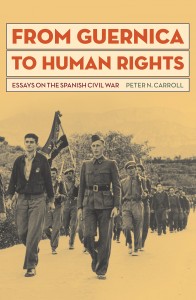 Reviewer: Wouter van Dijk
Reviewer: Wouter van Dijk
From Guernica to Human Rights. Essays on the Spanish Civil War, Peter N. Carroll
The Kent State University Press, Kent OH 2015
ISBN: 978-1-60635-238-0
Hardcover with dust jacket, with pictures in black and white, notes and index
205 pages
$34,95 / €43,99
Spanish Civil War research from an American perspective
The Spanish Civil War was in many ways an international war, most importantly because of German and Italian involvement and the participation of the so-called International Brigades, made up of volunteers from all parts of the world that were willing to defend the Republican government. Because of the international aspects of the war, it receives attention from scholars all over the world. Regarding the American involvement in the Spanish conflict, historian Peter N. Carroll has played an important part in shedding light on the many personal stories of American volunteers that went to Spain. A selection of his research has been brought together in this volume to encompass a lifetime of research into the Spanish Civil War and the lives of Americans that were involved in it. Carroll teaches history at Stanford University and is Chair Emiritus of the Board of Governors of the Abraham Lincoln Brigade Archives.
In Carroll’s book both new and earlier published essays from his hand are collected and subdivided into four main themes that are all evolving around the central subject of America and its connections with the Spanish Civil War. These themes are the American volunteers that went to help the Republic, writer Ernest Hemingway’s involvement in the war, the period after the war and the troubles it brought for American brigadeers once they returned home. Lastly, a section called ‘Postscripts’ contains some pieces that deal mostly with the long reverberating echo of Spanish Civil War experiences under participants.
The essays in the book are very diverse, ranging in time from the seventies to very recently and in subject from the participation of American women in the war to a lengthy correspondence between Hemingway and Hollywood employees working on the filming of For Whom the Bell Tolls. Especially in the pieces about individual volunteers Carroll’s personal approach comes into its own, for instance when he writes about the experiences of poet and screenwriter Alvah Bessie or the reasons of Salaria Kea to leave New York in order to go to Spain and help in a hospital. Oral history is, and has been, used frequently by Carroll, who considers it of utmost importance in the work of an historian.
Unfortunately due to the very different origins of the many articles in the book, introductory remarks about the war and repetitions are numerous and can be annoying. For those who don’t read the book from cover to cover though, as can be done with a volume like this, the short introductory sections at the beginning of each article can be quite useful. Carroll focuses almost exclusively on personal stories in his essays, be it fighting volunteers, caring nurses, a sympathetic writer or a forgotten hero. This is both the strength in his approach but also the weakness. Because focusing too much on the personal day-to-day worries of individuals might blur the wider image of the war and the analysis thereof. Therefore, I would not recommend this volume to someone looking for a book on America and the Spanish Civil War, it’s too fragmentary for that. To get a good idea of the width and variety of American experiences with the war however, Carroll’s compilation can be very useful and interesting indeed. Although his journalistic writing style may seem a bit too popularizing here and there for an academic audience and the form of a scholarly volume such as this, he argues with reason and analyses with knowledge of the facts.
Wouter van Dijk
